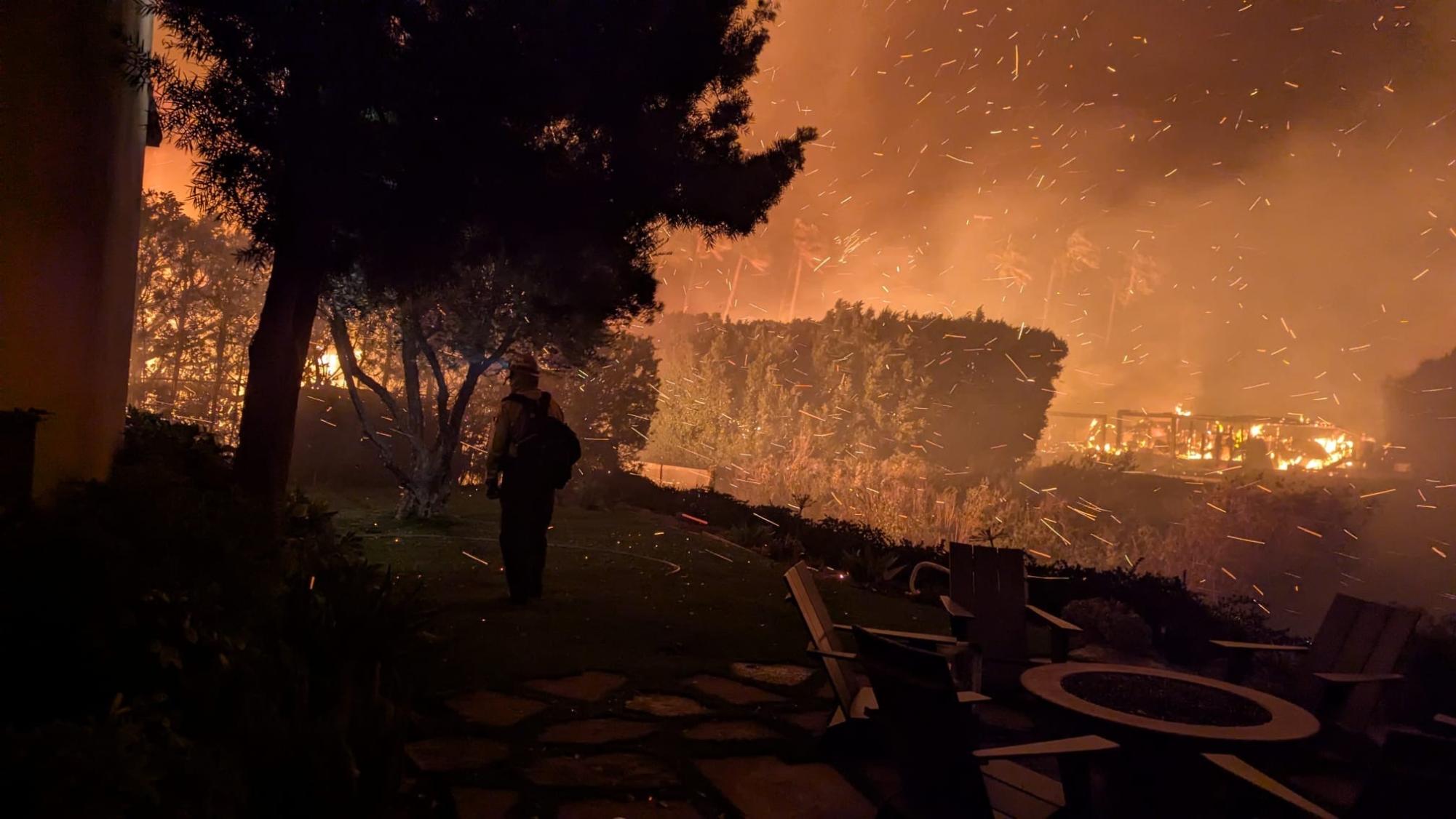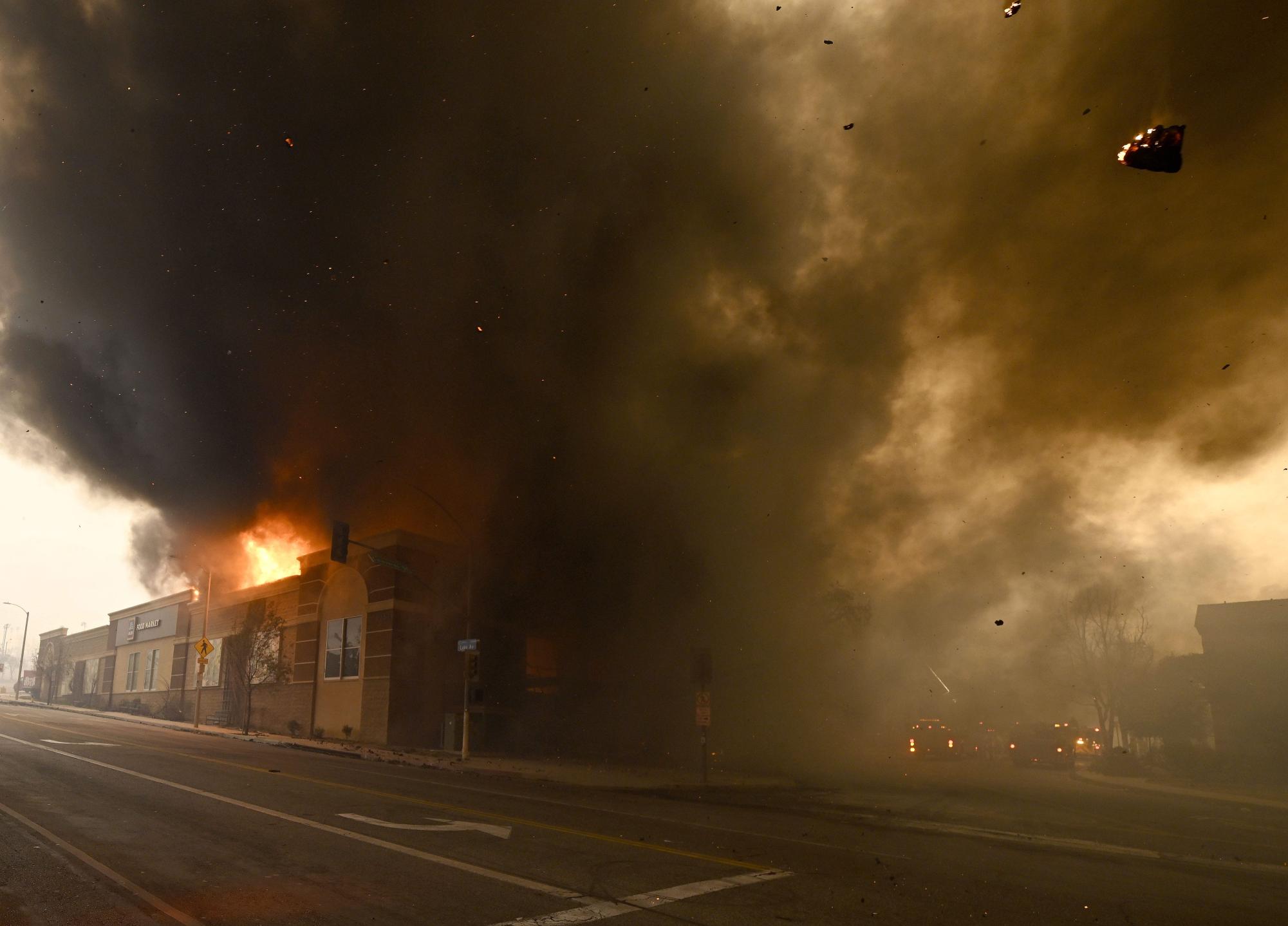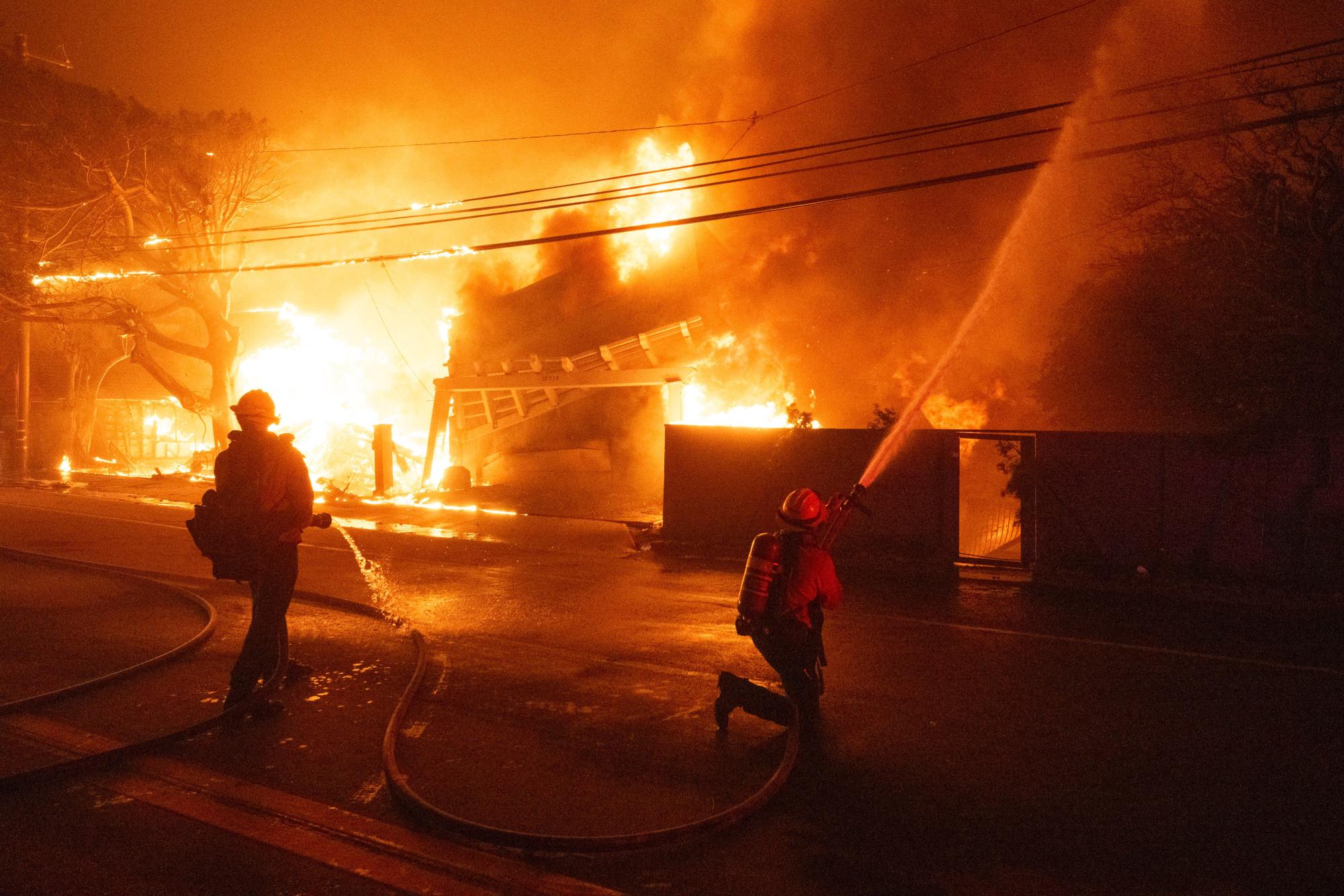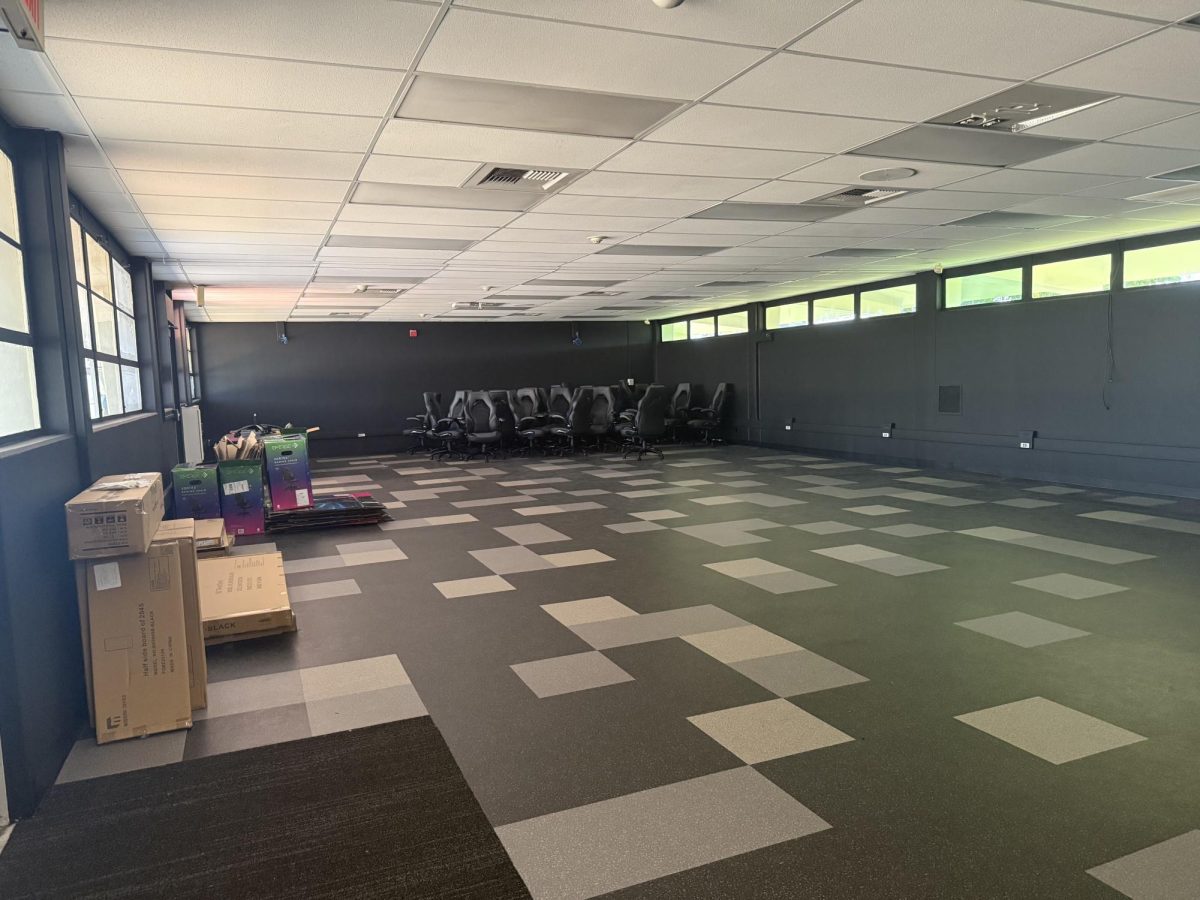Few in Los Angeles County will forget what happened on Tuesday, Jan. 7. It all started with over 80 mph Santa Ana winds, which the National Weather Service had warned would start swirling through Southern California starting at 10 a.m.
Though the causes remain unknown for what sparked the Palisades and Eaton fires – both over 40 miles away from Fullerton – the destruction left behind the following jarring numbers:
- total 37,469 acres burned
- at least 29 deaths
- dollar damage estimate at $250 billion
- 17 total blazes in Southern California from Tuesday-Friday, Jan. 7-31
And those who survived these infernos now turn to recovery efforts.
Meanwhile, many Sunny Hills students and staff couldn’t help but check their phones for notifications about the latest news of the havoc those fires wreaked. Some walking in the hallways complained of the ash smell in the air; others asked if anyone’s friends or relatives had to evacuate or lost their homes.
“I initially felt extremely worried when I heard about the fires because I have a lot of family extremely close to the Altadena area,” senior Melanie Ulloa said. “I was concerned about the evacuations of family members and preparing my place for them to stay at if necessary.”
Other concerns centered on the many unspoken words in the form of questions like, “Could this ever happen here in Fullerton?” “Am I and my family prepared if we had to evacuate our home?” and “What can I do to help?”
DORMANT RISKS AND PRECAUTIONS
Fullerton’s boundaries start with Houston Avenue to the South, Lambert Rd in the North, Kraemer Blvd to the East and Dale St in the West. Its total square mileage tops out at 22.4 square miles, less than the combined square mileage of the Altadena and Palisades area.
Outside the Sunny Hills campus and toward the border of the shopping center known as Amerige Town Center lies North Gilbert Street, which heads upward toward the 22,000-square-foot Coyote Hills area.
Motorists driving up that hill and toward La Habra can see stretches of various shrubs and dry brush beyond a thin chain-link fence, and further beyond that are large hills with various weeds.
Senior Jenna Forster’s father, Shon Halvorson, works as a firefighter-paramedic for Compton in Los Angeles County and recalled that Coyote Hills used to be classified as a fire hazard zone because of its dry brush and weeds, though it hasn’t been considered a fire risk area in recent years.
“[The] city of Fullerton does a pretty good job of weed abatement and making sure that we keep all of our weeds at a good level in our open areas,” Halvorson said.
Nevertheless, Fullerton Fire Department deputy chief Jonathan Fugitt said fire risk is always present no matter the region.
However, he said that the city of Fullerton is adequately prepared for a similar fire.
Fugitt said that Fullerton has an active fire prevention division that focuses on preventing fires and mitigating risks within the community.
The division focuses on regular safety patrols of businesses, apartments and schools as well as weed abatement inspections for adequate brush clearance. They also ensure that buildings in high fire severity areas follow the new stricter construction standards.
“Just because it was in L.A. doesn’t mean it can’t happen [here],” said Fugitt, who was assigned to assist with firefighting efforts in Palisades. “And where the fire was burning was in a neighborhood, just like any neighborhood in Fullerton.
When a fire gets established with high winds like that, the fire just goes from structure to structure. So I think it’s very important to have a well-staffed and well-trained and well-funded fire department.”
Fugitt was referring to the six fire stations in Fullerton that are fully staffed 24 hours a day, seven days a week. In addition to that level of protection, the city has contractual agreements from surrounding cities’ fire agencies if Fullerton’s firefighters ever need assistance.
“So if there is a fire or a disaster in Fullerton, … they can assist us if we need additional resources,” he said. “And then we’re also part of the California Mutual Aid System. So when you see a big fire or disaster anywhere in the state, you’ll see fire engines from all across California.”

COMMUNICATION IS KEY
Communication challenges also occurred in L.A., with a false evacuation alert on Thursday, Jan. 9, that was mistakenly sent to around 10 million L.A. county residents instead of those near the Kenneth Fire in West Hills.
This happened when Genasys, the official system responsible for the official emergency alerts, experienced technical issues.
Class of 2019 SH alumna Aleeya Mitsch, who lives in Sylmar where the Hurst Fire ignited on Tuesday, Jan. 7, was one of many people affected and could have used a more reliable communication system to help her respond to what was happening in her neighborhood.
“That day was very windy, so we were kind of debating whether or not to leave, but when we looked outside, we could see the fires,” Mitsch said. “So we just evacuated, and then 30 minutes later, my roommate got the evacuation warning [from the Wireless Emergency Alert system].”
She said it was around midnight when she and her mom noticed the fires and quickly packed and left.
“I think a lot of people were asleep because none of us really expected there to be a fire here,” the alumna said. “I realized how unprepared I was, and I’ve never actually packed expecting not to have a home to come home to.”
Following the evacuation, she regularly checked the Watch Duty app. This non-profit and non-government organization uses verified sources to provide the public with safety information through an app and an online browser.
Mitsch said she regularly checked the app after evacuating to know when she could return to the area.
In the end, Mitsch said her home was not affected, and she returned to the neighborhood within five days, although the smell of smoke persisted in the area.
To better prepare for a disaster in Orange County, Fugitt encourages all residents to sign up for AlertOC, a mass notification system run by Orange County and participating cities that provides alerts about emergencies in the area. The City of Fullerton website also has fire prevention and preparedness information.
“It’s pretty devastating to what the fires did to the communities surrounding the Eaton and Palisades fires, and I think it serves as a reminder to be fire-wise and to make sure that we have a fire-safe community,” the deputy chief said.

FINDING CREDIBLE ORGANIZATIONS TO HELP FIRE VICTIMS
Meanwhile, a large-scale effort was organized on Jan. 30 that brought out several musical artists like Lady Gaga, Billie Eilish and Red Hot Chili Peppers to encourage viewers to support fire victims. The estimated $100 million in proceeds were given to the Annenberg Foundation, an L.A. non-profit group that was helping to distribute the goods to those affected.
Nearly a decade ago in September 2017, Sunny Hills supported Fivay High School in Florida following the devastation from Hurricane Irma by raising funds to help with the recovery and collecting clothing and canned goods.
But that has yet to happen with this disaster, and only one effort was promoted on campus to help fire victims.
National Honors Society [NHS] president senior Sophia Kiker organized an opportunity for students to donate goods from Monday-Wednesday, Jan. 13-15. Anyone wanting to help brought items to Room 5 and 6, Kiker said.
Canned food, clothing and other items were donated to the L.A. City Council District 11 Office, which was accepting and distributing the donations to the affected community, she said.
“While we don’t have a quantifiable number of donated items, the stacked bags and boxes filled up half of Room 35 and took three cars to transport,” Kiker said. “We wanted Sunny Hills to also be included in this, the entire school, so that everyone else would experience what it’s like to serve and also be a leader in our community.”
Associated Student Body [ASB] adviser David Fenstermaker said the school has not yet arranged any efforts to aid those affected by the fires because he wants to ensure he picks the correct organization.
“Somebody wanted to pair with ASB … and my issue was, and still is, that it’s great to help, except we can’t be positive,” Fenstermaker said. “We really need to do our research on the right group, so to speak, because someone can pop up and be like … ‘I’m gonna give all this money,’ and then you give him money, and then he just takes it for himself.”







